There is a book which is a faithful representation of the Universe.
Borges would have loved its story. Here it is.
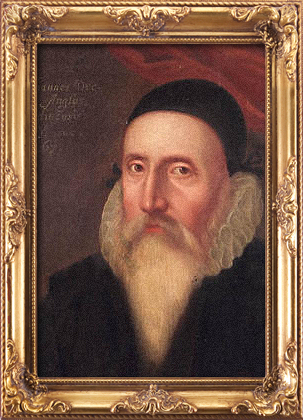
Put yourself in John Dee’s shoes. You have been interested in magick and occult since many years, and you have in your hands a incomprehensible magic book. Its pages are covered by more than 40 thousand randomly distributed letters. You suspect they hide a message, but in many years you failed to penetrate their secret. Your colleague Edward Kelley (1555-1597) offers you to interview the Archangel Uriel. Wouldn’t you start your conversation asking him to reveal you the mysterious code?
It really happened on March 10, 1582.
London, Mortlake District. Kelley has with himself a special mirror, through which the Archangels speak using its voice. (1) Uriel is on the line. The first question by Dee is about the mysterious Book of Soyga (2) :
John Dee: “Ys my boke, of Soyga, of any excellency?”
Speaking through Kelley, Uriel replies:
Uriel: “Liber ille, erat Ada[m]e in Paradiso reuelatus, per Angelos Dei bonos.”

The dialogue between Dee (signing himself with a delta letter) and VR (Uriel)
taken from the Spiritual Diaries written by the alchemist.
The Archangel speaks in Latin, explaining that the pages of the books are special: they were revealed to Adam by the “good angels of God” in the garden of Eden. Dee asks Uriel how to interpret its content:
John Dee: “Will you give me any instructions, how I may read those Tables of Soyga?”
The question is related to the peculiar structure of the final 36 pages of the book, all showing a big square made of 36 rows per 36 columns of Latin letters, for a total of 46,656 characters; the resulting text is incomprehensible, and no word can be easily recognised.
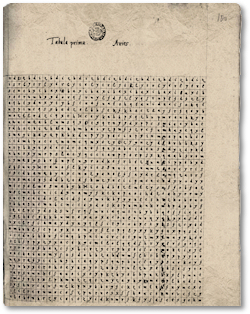
“Book of Soyga”, Table 1 (Aries), Bodleian Library, Oxford University, MS Bodley, 908, fol. 180r.
Uriel explains that only the Archangel Michael knows its secret:
Uriel: “Solus Michael illius libri est interpretator.”
Dee is worried by the voices about the book, according to which its secrets would bring to death in 2 years and a half; Uriel is vague about this point, replying: “Thow shallt liue an Hundred and od yeres.”
According to skeptics, Kelley was forced to be vague about the topic, ignoring himself the secret of the book. At the end of the conversation, no information given by Uriel is of any use for Dee. On April 24, 1583 the alchemist will take a note on his diary which will be of paramount importance in our century: the book shows the alternative title “Aldaraia”.
Many years later Elias Ashmole (1617-1692) confesses of having seen the book in the personal library of Lauderdale’s Duke, citing the complete title on the first page: “Aldaraia sive Soyga vocor”. (3)
From this moment on, the “Book of Soyga” is lost.
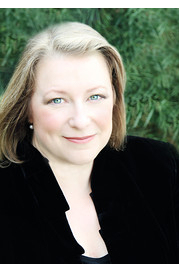
Today Deborah Harkness is a historian and novelist, working at the University of Southern California in Los Angeles. In 1994 she was working on a dissertation about John Dee. Reading his diaries, and finding references to the dialogue with Uriel, she asked herself where the “Book of Soyga” could be. The conversation between Dee and Uriel took place in London, so she started her quest at the British Library. She immediately found it, catalogued under its alternative title – “Aldaraia sive Soyga vocor”; everyone, before her, coudn’t find it under the letter “S” of “Soyga”! A second book was found in Oxford at the Bodleian Library under the same, alternative title.
Four centuries after Dee’s inquiry, we can try to solve the same enigma: is there a order behind the 40,000 letters spread on its 36 tables?
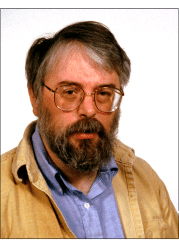
James A. Reeds is a mathematician who lives in Princeton. A lover of ancient esoteric books, for years he has been part of a working group dedicated to the decipherment of the Voynich manuscript. The “book Soyga” is an irresistible challenge for him:
We know the tables in the Book of Soyga excited John Dee’s interest, as seen in the dialogue with Uriel. They certainly also excited mine as a professional cryptologist. Were they, I wondered, filled with a random (and hence pointless) selection of letters, or were they a cryptogram (with a hidden ’plain text’ meaning, which might at least in principle be recoverable by cryptanalysis), or was there some other structure or pattern to them? (4)
Through a series of microfilm, Reeds transcribed on the computer all the 46,656 letters, with the aim of identifying the order that lies behind the apparent chaos. After a detailed study, Reeds come across the startling answer to the puzzle: each table is based on a “magic word” of 6 letters, which constitutes the “seed”, different on each page; a simple equation allows to calculate all the letters of the square 36 × 36.
The rule to fill each table is incredibly easy. What letter should we write on the square with the black border?
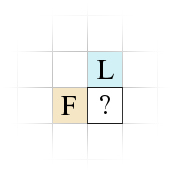
To “calculate” it we must rely on the letter above and the one on the left. The above letter (L) tells us where we need to start on the blue wheel. The letter on the left (F) has a number on the corresponding yellow tile (like in the game of Scrabble) – in this case 2. This number tells us how many clockwise steps we have to do.
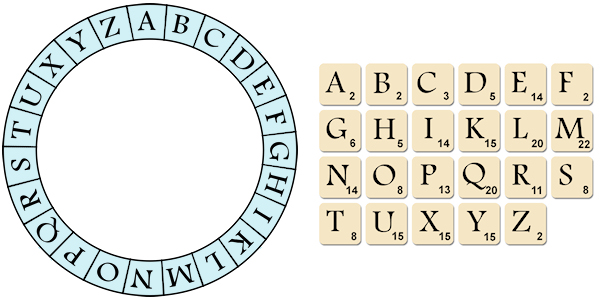
The wheel on the left is similar to the mnemonic wheel of Ramon Llull (1235-1316).
Taking 2 steps clockwise from L we get N: we have found the letter to be written!
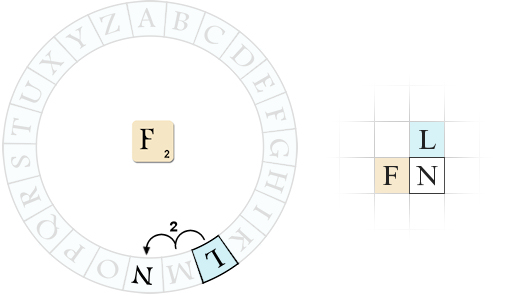
Here is a fragment of the first table, in which the link between the three letters is highlighted:

How to calculate the letters in the top row, not having any letters over them? In this case, the letter on the left assumes both roles: it represents both the section of the blue wheel from which we have to move and the yellow tile specifying the number of steps. What letter should we write in the square with a black border?

The B on the left shows us where to start on the wheel, and because its tile shows the number 2, we are informed that we must move two steps clockwise, coming to the letter D.
Here is a snippet of the first table, where the link between the two letters is highlighted:
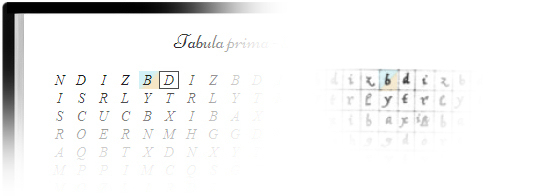
The last question concerns the letters of the first column, not having any letter on the left. Here comes the magic word – the “seed” of the table. In Table 1, the magic word is NISRAM, so the first column starts with the same letters. Immediately after, the same word is written in reverse (MARSIN), alternatively for three times. The first column will then be: NISRAMMARSINNISRAMMARSINNISRAMMARSIN
C’est tout!
Discovering this rule, Reeds could check with his computer all the errors committed by the two scribes in creating the two known copies of the “Book of Soyga”. The same simple rule has allowed me to create an electronic version of the book (click here to access it):
The first 24 tables of the book are named after the constellations of the zodiac, two tables for each sign, followed by 7 tables named after the planets, the 4 natural elements and the figure of “magister”. The entire content of each page is determined by the magic words listed here in CAPITALS:
Aries: NISRAM
Taurus: ROELER
Gemini: IOMIOT
Cancer: ISIAPO
Leo: ORRASE
Virgo: OSACUE
Libra: XUAUIR
Scorpio: RAOSAC
Sagitarius: RSADUA
Capricornus: ATROGA
Aquarius: SDUOLO
Pisces: ARICAA
Aries: MARSIN
Taurus: RELEOR
Gemini: TOIMOI
Cancer: OPAISI
Leo: ESARRO
Virgo: EUCASO
Libra: RIUAUX
Scorpio: CASOAR
Sagitarius: AUDASR
Capricornus: AGORTA
Aquarius: OLOUDS
Pisces: AACIRA
Saturni: OSRESO
Jovis: NIEBOA
Martis: OIAIAE
Solis: ITIABA
Veneris: ADAMIS
Mercurii: REUELA
Lunae: UISEUA
Ignis: MERONF
Aeris: ILIOSU
Aquae: OYNIND
Terrai: IASULA
Magistri: MOYSES
It is curious to note that the two tables entitled to the Aries have two magic words of which one is the reverse of the other (NISRAM and MARSIN), and the same is true for all 12 zodiac signs.
Two historical questions remain: why those magic words? and what criteria was used to assign a numerical value to the letters on yellow tiles?
It is so easy to “calculate” the tables of Soyga with the aid of a computer that I created a form to customize the seed, enabling the user to choose his own favorite “magic word”. What would it look like the table originating from the magic word “abracadabra”? Here it is!
Despite Jim Reeds has discovered the secret of the “Book of Soyga”, after two years and a half he is still alive. Is it because he just analysed its structure, without venturing into its content or use? Am I running a risk in formulating a hypothesis about its symbolism?
The Gospel of John does not describe the big bang as a scientist would do today; according to the Evangelist:
“In the beginning was the Word, the Word was with God, and the Word was a God”
This would be literally true if a table of the “Book of Soyga” was a universe: to “create” all that is, only a word is needed – just called “seed”.
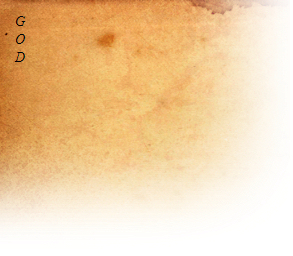
The angle at the top left of the Universe-book, with one of the possible seeds (GOD).
The parallel between the Book and the Universe is not arbitrary: in the sixteenth century Galileo Galilei (1564-1642) compared the world to a
grand book – I mean the universe – which stands continually open to our gaze, but it cannot be understood unless one first learns to comprehend the language in which it is written. It is written in the language of mathematics.
The Italian scientist identifies in mathematics the “not material” element that gives shape and order to the matter; together, mathematical laws and physical substances define everything exists.
Similarly, as a universe created by a single word, a table of Soyga use two mathematical rules to define everything that exists. The first requires to transcribe the seed on the first column, alternately with its reverse form:
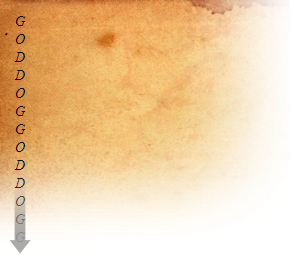
The angle at the top left of the Universe-book, with the seed reported infinite number of times on the first column.
The second mathematical rule allows to populate the entire table with the letters arranged in an (apparently confused) order, determined by the word set at the beginning in the top left:

The angle at the top left of the Universe-book, with the content calculated on the basis of the mathematical rule described.
The universe defined by the “seed” and by the two mathematical rules is infinite: it extends indefinitely down and right, resulting in seemingly random patterns of letters (and a modern mathematician is surprised to find in a manuscript of the sixteenth century, an equation so similar to those studied today in Chaos Theory).
The tables of the Book of Soyga are nothing but portions of these universes, filtering the first 36 rows and columns of each. Since different seeds generate completely different universes, the 36 panels exploring the many worlds that emerge from NISRAM (under the sign of Aries), ROELER (under the sign of Taurus), IOMIOT and so on.
Half a millennium after John Dee we can explore new worlds, choosing the “seed” and comparing – for example – and the Universe created by IEHOVA and the one by ALLAH.

From this point of view, not surprisingly Uriel traced the book back to Adam: in fact, its structure perfectly mimics the creation of the World from a Word and a mathematical rule.
One conclusion that would have excited Borges: because the “Book of Soyga” is a faithful representation of the Universe.
1. D. E. Harkness, “Shows in the Showstone: A Theater of Alchemy and Apocalypse in the Angel Conversations of John Dee (1527-1608/9)”, Renaissance Quarterly, 49 (1996), 707-737.
2. See the original conversation on the Spiritual Diaries by John Dee, Sloane 3188, fol. 9r. The page can be downloaded from here.
3. Sloane 3677, British Library, London.
4. Jim Reeds, “John Dee and the Magic Tables in the Book of Soyga” in Stephen Clucas (ed.), John Dee: Interdisciplinary Studies in English Renaissance Thought, International Archives of the History of Ideas, No. 193. Dordrecht, Netherlands: Springer, 2006, pp. 177-204. Download it from here.
BY-NC-SA 4.0 • Attribution-NonCommercial-ShareAlike 4.0 International